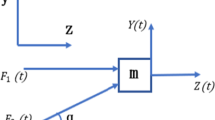Abstract
In this paper, orthogonal cutting experiments and a simulation analysis of ultrasonic elliptical vibration cutting (UEVC) of hard material were performed by adopting a resonant UEVC actuator. The effects of the cutting regime parameters (ultrasonic elliptical vibration excitation, cutting speed, crossfeed, and depth of cut) on the cutting resistance, chip morphology, and surface integrity during the UEVC process were experimentally investigated. The von Mises stress distribution in the primary deformation zone in one ultrasonic elliptical vibration cycle was used to describe the cutting nature of UEVC. It was also shown through both analysis and experiments that the cutting resistance in UEVC is lower as compared to conventional cutting. At last, the different nature of the chip formation mechanisms in the two processes were also analyzed through a free body force analysis of the chip. The chip shapes from experiments and finite element analysis (FEA) are compared and discussed based on the average equivalent plastic strain in the chip.
Similar content being viewed by others
References
Gardner L (2005) The use of stainless steel in structures. Prog Struct Eng Mater 7(2):45–55
En, B (1995) 10088–1. Stainless steels—part 1: list of stainless steels. British Standards Institution
Thamizhmanii S, Hasan S (2011) Machinability of hard martensitic stainless steel and hard alloy steel by CBN and PCBN tools by turning process. Proceedings of the World Congress on Engineering 2011(1):554–559
Liew W (2009) Experimental study on the performance of coated carbide tools in the ultra-precision machining of stainless steel. Tribol Trans 52(3):293–302
Skelton R (1968) Turning with an oscillating tool. International Journal of Machine Tool Design and Research 8(4):239–259
Zou P, Xu Y, He Y, Chen M (2015) Experimental investigation of ultrasonic vibration assisted turning of 304 austenitic stainless steel. Shock and Vibration.
Moriwaki T, Shamoto E (1991) Ultraprecision diamond turning of stainless steel by applying ultrasonic vibration. CIRP Annals-Manufacturing Technology 40(1):559–562
Shamoto E, Moriwaki T (1999) Ultaprecision diamond cutting of hardened steel by applying elliptical vibration cutting. CIRP Annals-Manufacturing Technology 48(1):441–444
Zhang X, Kumar A, Rahman M, Nath C, Liu K (2011) Experimental study on ultrasonic elliptical vibration cutting of hardened steel using PCD tools. J Mater Process Technol 211(11):1701–1709
Suzuki N, Nakamura A, Shamoto E (2003) Ultraprecision micromachining of hardened steel by applying ultrasonic elliptical vibration cutting. Proceedings of 2003 International Symposium on Micromechatronics and Human Science 2003:221-226
Ammouri A, Hamade R (2009) A bi-directional ultrasonic elliptical vibration actuator for micromachining. ASME 2009 International Mechanical Engineering Congress and Exposition 4:523–527
Song Y, Park C, Mariachi T (2010) Mirror finishing of Co–Cr–Mo alloy using elliptical vibration cutting. Precis Eng 34(4):784–789
Suzuki N, Nakamura A, Shamoto E, Harada K, Matsuo M, Osada M (2003) Ultraprecision micromachining of hardened steel by applying ultrasonic elliptical vibration cutting. Proceedings of 2003 International Symposium on Micromechatronics and Human Science, p 221–226
Moriwaki T, Shamoto E (1995) Ultrasonic elliptical vibration cutting. CIRP Annals-Manufacturing Technology 44(1):31–34
Guo P, Ehmann KF (2013) Development of a tertiary motion generator for elliptical vibration texturing. Precis Eng 37(2):364–371
Xu Y, Zou P, Yang X, He Y (2013) Study on ultrasonic generator for ultrasonically assisted machining. Advanced Materials Research Trans Tech Publ 797:320–325
Che D, Saxena I, Han P, Guo P, Ehmann KF (2014) Machining of carbon fiber reinforced plastics/polymers: a literature review. J Manuf Sci Eng 136(3):034001
Dhar N, Kamruzzaman M (2007) Cutting temperature, tool wear, surface roughness and dimensional deviation in turning AISI-4037 steel under cryogenic condition. Int J Mach Tools Manuf 47(5):754–759
Matsumoto Y, Hashimoto F, Lahoti G (1999) Surface integrity generated by precision hard turning. CIRP Annals-Manufacturing Technology 48(1):59–62
Pettersson U, Jacobson S (2006) Tribological texturing of steel surfaces with a novel diamond embossing tool technique. Tribol Int 39(7):695–700
Tian H, Saka N, Suh NP (1989) Boundary lubrication studies on undulated titanium surfaces. Tribol Trans 32(3):289–296
Wakuda M, Yamauchi S, Kanzaki S, Yasuda Y (2003) Effect of surface texturing on friction reduction between ceramic and steel materials under lubricated sliding contact. Wear 254(3):356–363
Nath C, Rahman M, Neo K (2008) A study on ultrasonic elliptical vibration cutting of tungsten carbide. J Mater Process Technol 209(9):4459–4464
Shao YJ, Wang JQ, Zhu X, Chen Q (2011) The study of power ultrasonic vibration cutting heat. Advanced Materials Research. Trans Tech Publ, 297–300
Ng EG, Aspinwall DK (2002) Modelling of hard part machining. J Mater Process Technol 127(2):222–229
Babitsky V, Mitrofanov A, Silberschmidt V (2004) Ultrasonically assisted turning of aviation materials: simulations and experimental study. Ultrasonics 42(1):81–86
Shampoo E, Mariachi T (1994) Study on elliptical vibration cutting. CIRP Annals-Manufacturing Technology 43(1):35–38
Chen R 1992 Principle of metal cutting. China Machine, Beijing
Rowe GW, Spick P (1967) A new approach to determination of the shear-plane angle in machining. Journal of Engineering for Industry 89(3):530–538
Zhou L, Huang ST, Wang D, Yu XL (2011) Finite element and experimental studies of the cutting process of SiCp/Al composites with PCD tools. Int J Adv Manuf Technol 52(5–8):619–626
Ponkshe GP (1967) A new explanation of the phenomenon of chip curling during machining. Journal of Engineering for Industry 89(2):376–379
Author information
Authors and Affiliations
Corresponding author
Rights and permissions
About this article
Cite this article
He, Y., Zou, P., Zhu, WL. et al. Ultrasonic elliptical vibration cutting of hard materials: simulation and experimental study. Int J Adv Manuf Technol 91, 363–374 (2017). https://doi.org/10.1007/s00170-016-9716-8
Received:
Accepted:
Published:
Issue Date:
DOI: https://doi.org/10.1007/s00170-016-9716-8




